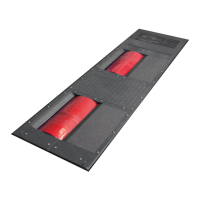BA053101-en
Pos: 128 /Tech nische D okumen tation/A lle G eräte/ Überschr iften/Üb ers chrifte n 1.1/B/ Übersc hrift 1.1: Ber echnun gsgrund lagen @ 13\m od_12 34259 9261 27_7 5.docx @ 33699 5 @ 2 @ 1
Pos: 129 /Tech nische D okumen tation/A lle G eräte/ Überschr iften/Üb ers chrifte n 1.1.1/ F/Übersc hrift 1 .1.1: F ahrw iderstä nde @ 13\mod_1234260532279_75.docx @ 337111 @ 3 @ 1
Pos: 130 /Tech nische D okumen tation/ Leistu ngsmess techni k/POWE RDYNO/052301 LPS 3000 R100/BA/Inhalt: 0523 Fahrwiderstände @ 13\mod_1234260604469_75.docx @ 337167 @ @ 1
Equation
m a
v
3,6
P
v
v
3,6
P
v
v
3,6
P
F
ref
Roll
2
ref
Flex
3
ref
2
Air
x
⋅+
⋅
+
⋅
⋅
+
⋅⋅
=
with
• v
ref
Reference speed for resistance performance values - normally 90 km/h.
• v Driving speed
• P
air
Air resistance performance [kW]
• P
flex
Flex performance [kW]
• P
Roll
Roll resistance performance [kW]
• a.m Vehicle mass
Air resistance power P-Air [kW]
The air resistance power is proportional to the surface of
the vehicle front and air resistance coefficient c
w
.
v ) v (v A c 0,5 P
2
0FrontWAir
⋅+⋅⋅⋅⋅=
r
with e.g.
• Air density r (rho)
= 1.1 kg/m
3
• air resistance coefficient
c
W
= 0.38
• Front surface
(VEH-width x Height)
A
Front
= 1.7 m · 1.47m = 2.5 m
2
• Driving speed
v = 90 km/h = 25 m/s
• Head wind speed
v
0
= 0 m/s
results:
• P
air
= 0,5 · 1,1 · 0,38 · 2,5 · 25
2
· 25
= 8.164 kW at 90 km/h
Flex power or resistance is defined as the power loss
which occurs due to the flexing of the tire on the road
surface and/or roller.
Generally speaking the flex power does not have a relevant influence on the test results due to the
minimal flex resistance coefficient.

